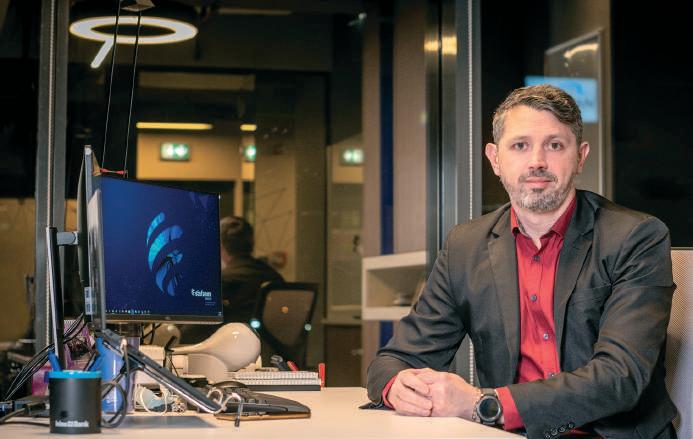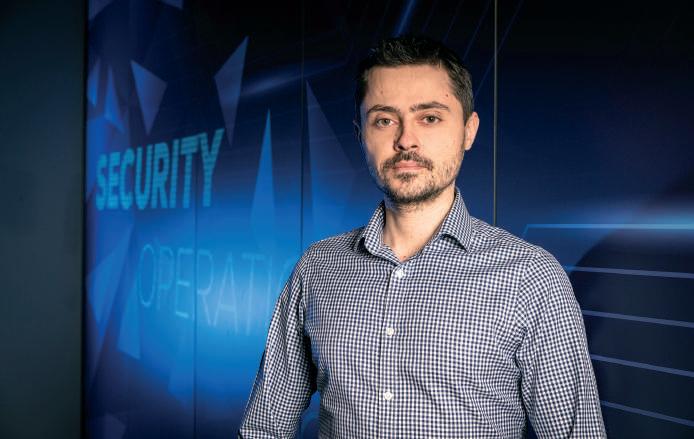
14 minute read
BAm nr 99
Business Arena No.99/2021
FARLEI KOTHE, FARLEI KOTHE, CEO STEFANINI EMEA
Advertisement
RESILIENCE IS THE KEYWORD FOR COMPANIES IN 2021
www.business-arena.ro / www.businessarena.ro ”
“We have We have all gone online in the all gone online in the past year to a certain past year to a certain extent, regardless of extent, regardless of our industries, and this our industries, and this shift brought along not shift brought along not only opportunities, but only opportunities, but also threats that many also threats that many companies were not companies were not familiar with. familiar with.
For Stefanini, the global tech multinational originating from Brazil, the past year has offered no opportunity for standing still. As with many other tech giants, the company was very busy throughout 2020, responding to the pandemic that has forced many companies to accelerate their digital transformation.
“We had started our own digital transformation journey long before 2020 rushed us all in this direction,” says Farlei Kothe, the CEO of Stefanini in the EMEA region. “We are now in the position to lead and guide our customers as seamlessly as possible through the digital transformation process, which is no longer
optional for any company. We have all gone online in the past year to a certain extent, regardless of our industries, and this shift brought along not only opportunities, but also threats that many companies were not familiar with. Cyber threats, in particular, became a challenge, especially for companies in industries that had not been the traditional focus of hackers, such as medical companies, industrial companies, entrepreneurial companies, government agencies and so on.”
These new risks prompted Stefanini to expand its focus on cybersecurity in the region last year. Provider of IT services for more than 33 years, in 41 countries around the globe, Stefanini entered the cybersecurity market in 2016, when it started a joint venture with Israel-based Rafael Advanced Defense Systems. The company leverages Rafael’s technology designed for military-grade cybersecurity and its own global sales channels. Stefanini Rafael Segurança e Defesa’s managed security services have grown rapidly in Brazil since the joint venture was announced. The company soon opened another Security Operations Center for Latin America as the demand in the region was on the rise. In the EMEA region, Romania is a key market for Stefanini, especially when it comes to acquisitions or strategic joint ventures. As a result, when plans to expand the cybersecurity pillar outside Latin America took shape, a local investment here was the next logical step. Therefore, in 2020, Stefanini joined forces with the Romanian company Cyber Smart Defence (CSD), one of the most dynamic cybersecurity companies in the country. Stefanini Group has also recently opened a Security Operations Center (SOC) in Bucharest to cover the needs of its clients in the entire region. Meanwhile, CSD plans to grow its turnover up to five million euros in the next three years.
The timing could not be more perfect, as Bucharest has recently been appointed to host the European Cybersecurity Competence Centre, the hub that distributes EU and national funding for cybersecurity research projects across the community bloc.

“WHAT STEFANINI AND CSD HAD TO OFFER EACH OTHER WAS ONE OF THE MOST VALUABLE ASSETS ONE COULD TRADE THESE DAYS: TIME
“Leaving aside any investment figures, Stefanini Group and CSD signed a strategic partnership,” says M\d\lin Dumitru, founder of Cyber Smart Defence and CEO of the new joint venture. “We are investing in the future together, and what we had to offer each other was one of the most valuable assets one could trade these days: time. Stefanini gained instant access to the local cybersecurity market,
without having to go through the usual trial and error phase, and we were happy to gain access to an extremely valuable pool of clients, which would have definitely meant an important time and effort investment on our part if it hadn’t been for Stefanini.”
The tech giant follows a strategy of acquiring or setting up joint ventures with young and ambitious local entrepreneurs from all over the world, offering them a global platform for their solutions and services and, at the same time, constantly expanding and refreshing its own portfolio. In 2019, Stefanini Infinit was the first such joint venture in Europe, focusing on marketing and digital. Cyber Smart Defence followed in 2020, focusing on cybersecurity services, but the expansion plans continue for the Brazilian tech multinational.
“We are constantly looking for new and innovative solutions, expanding our global ecosystem to provide true digital transformation to our clients. To this end, we plan to add at least two new ventures every year to our portfolio,” says Farlei Kothe. “We are in the final phase with a new acquisition in Romania, a deal that we will close in the first semester, and we plan for another venture in the region later this year. We have several discussions open in different stages with potential partners and we are constantly trying to expand to key markets.”
DIGITAL HYGIENE, AS IMPORTANT AS PHYSICAL HYGIENE THESE DAYS, SAYS ALEXANDRU BERTEA, CHIEF CYBERSECURITY STRATEGIST AT STEFANINI EMEA
Back to cybersecurity, 2020 was of paramount importance for the industry. “Security is countercyclical: this industry tends to grow while broader macro conditions deteriorate,” explains Alex Bertea, Chief Cybersecurity Strategist, Stefanini EMEA. “During the pandemic, the need for cybersecurity services increased, especially as a result of the shift towards remote working, but also because specific security trends have accelerated a digital transformation process that was already underway.”
The losses caused by cybercrime for companies in 2020 were around two trillion USD. For this year, they are estimated to be no less than six trillion USD. “Historically, this figure never dropped,” says Alex Bertea. “This is why digital hygiene has become just as important as physical hygiene these days.”
Think of it this way, he says: “Every second, a cyberattack happens in the EU. Some 43% of the costs of cyberattacks come from data loss and data leaks. Hackers are prepared to sell personal data for amazingly cheap prices. The figure varies between 20 cents and 15 US dol-

http://www.business-arena.ro 8

lars. A lot less than one would assume. At the streaming from. Cybersecurity teams now have same time, the damages are hard to quantify, to secure not just some parts of the organizaas they are not just direct costs, they can tion but the entire organizations, protecing all cause significant reputational damage and employees within their work from home enviother losses that are harder to quantify but ronments, as well as all the applications they very significant.” interact with.
Last year can be viewed as the first step in Speaking on his experience at Cyber Smart a move towards a completely different way of operating. “There is no going back to the “busi- ALEX BERTEA, ness as usual” CHIEF CYBERSECURITY model that we knew before the pandemSTRATEGIST, ic,” says Farlei STEFANINI EMEA Kothe. “Companies will have to develop a new way of doing business if they want to thrive and move forward. And this new model definitely includes digital transformation, accompanied by a solid cybersecurity strategy and defense plan.” Defence, part of Stefanini Group, M\d\lin
Alex Bertea explains the magnitude: “Clients Dumitru explains: “These days, cybersecurity are now shifting from on premises and hybrid and physical health are our most important to cloud environments and are using these concerns. Some 98% of the IT systems we services actively. We are not talking about 5% have tested had critical vulnerabilities. At the of the users in a company anymore, it’s usually same time, 95% of the owners and IT directors more than 80% of the users that are interact- of these companies believed that they did not ing with these environments. So, this has have any major security problems in their infrabecome a greater challenge for security teams structure.” in a very short period of time. In addition to According to Netwrix’s 2020 IT Trend the data that users voluntarily provide when Report, the topic of data security has become accessing a specific application, there is also a priority for three out of four companies in data that is collected automatically by the sim- 2020. If companies were spending their budgple fact of visiting websites, through devices, ets on cybersecurity products a few years ago, such as Beacons, Crawlers and Cookies. Once lately, they are turning to cybersecurity outa company that manages such data is compro- sourced services, performed by highly trained, mised, data will be lost, and it can be auc- specialized professionals, with the pandemic tioned in dark markets for less than one dollar. demonstrating the importance of this field. Also, deep fake technology is not just a prank “A successful cyberattack is performed by anymore or a tweet or a very nice Instagram hackers rather than by machines or software, post but a real threat. These ransomware prac- which is why improving security should take tices can leave an entire company paralyzed the same approach, using the same human for days, weeks or maybe even months. skills and the appropriate mindset. I believe Sometimes, the demands are so high that they making use of a human team of ethical hackcan really leave a company on the verge of ers to secure systems is the correct bankruptcy.” approach,” says M\d\lin Dumitru.
Security goes hand in hand with technology It is estimated that 3.5 million jobs may be and product development, which is why com- generated by the cybersecurity market in panies need to secure their apps, the end- 2021. Stefanini is one of the highly active and points, and all the laptops and devices they are rapidly growing players on the market and is
http://www.business-arena.ro http://www.business-arena.ro 10

WHEN CENTRAL BANKS AGREE TO PLAY DANGEROUS GAMES FOCUS ON TURKEY
Who pays for central bank decision makers' hasty monetary policy decisions, based on incorrect assumptions, taken under pressure or simply taken wrongly, although more than likely with good intentions? How expensive are these errors and who pays for them? I'm trying to answer below.
BY CRISTIAN POPA
Certainly, bad decisions have been and will be made. It is enough to look at Latin America, or the 70s, when central banks created high inflation, which they eventually managed to control, but with huge economic costs.
Central banks have been and still are key players in the economic response to the pandemic. Many measures have been taken in the last year, but when analyzing those measures the findings are quite nuanced. The type and the extent of the measures taken were completely different between developed countries (issuing reserve currency, dollars and euros for example) and emerging countries (which do not issue reserve currency).
Why didn't small countries use the same tools as the US Federal
Reserve or the European Central
Bank? What is the difference?
As today's money is no longer "gold-backed", the system is based on trust, on the confidence that the central bank that issued it will not destroy its value by "printing" new money without limit. In simple terms, the difference comes from the degree of confidence that each country, its central bank, and currency enjoy. While investors are ready to keep their savings in euros or dollars even at zero yields, would they accept the same for Turkish lira or Argentine peso? The answer is most likely no. This leads to balancing yield against risk. For a currency considered "safe", the issuing central bank allows itself to lower its interest rate to zero and even print new money because the markets trust its policies, so they trust that it will "follow the rules," and thus it will not create excessive inflation. But for a currency considered "risky", the central bank that issues it does not enjoy such a privilege. It must compensate in some way for the higher risk attached to it, the risk of "not following the rules to the letter," the higher natural interest rate, and the higher rate (and persistence) of inflation in that country. And this compensation is achieved through a higher “cost of capital”: higher interest rates or an undervalued (depreciated) exchange rate.
The above-mentioned equation is actually more complex, especially in terms of "observance of the rules" by the central banks, but to keep things simple we will not go into details here.
Coming back to our topic, if interest rates do not offset the risk perceived by the market, or are lowered by the central bank (despite a reality that would justify otherwise) to unsustainably low levels, then the markets react: investors sell that currency against other currencies with a better risk/ return ratio, thus generating depreciation pressures for the national currency (investors will do this despite the fundamental factors, which act over time, in the long run). The country's own citizens will probably make currency exchanges, fearing a further depreciation and hoping to maintain the purchasing power of their personal savings. They will do so even if they
CRISTIAN POPA

perceive the "strong" currency (euro, dollars) as a better alternative to their national currency. Higher inflation in the country also makes citizens abandon the national currency in favor of a currency which is more easily convertible into other international currencies. These are some of the elements that generate currency depreciation pressure.
In summary, steep and sudden interest rate cuts in emerging countries often lead to a loss of confidence in the central bank, to the migration of capital out of the country, and ultimately to a depreciation of the exchange rate. In turn, depreciation leads to higher inflation, because it makes imported goods more expensive. Higher inflation causes more depreciation, as citizens and investors will seek to protect their savings from inflation by buying currency and importers will raise prices as a way to cover the devaluation risk, at least partially. Thus, we see a spiral of depreciation generated by inflation and vice versa, while the decision makers' mistake is becoming obvious. To stop the spiral and depreciation, the central bank must acknowledge its mistake and intervene to restore the lost confidence. Thus, it must increase the interest rates even above the previous equilibrium level.
But trust is hard to gain and easily lost: raising interest rates must be credible, and inspire confidence, otherwise the effect will not be as expected. And correcting the mistake is accompanied by costs: the depreciation will probably be stopped, but not reversed, and the sudden and significant increase in interest rates has a negative impact on economic activity, investment, and unemployment.
Who pays the bill?
The bill is paid by all those who trusted the local authorities (monetary and fiscal) and the national currency. Citizens, companies as well as foreign investors who have kept their savings and investments in the national currency lose a part (perhaps significant) of their wealth. But among those who stand to lose there are also vulnerable individuals, with low and fixed incomes, because inflation erodes their purchasing power. Inflation is the most infamous tax. Many savings evaporate due to inflation. Moreover, those who have debts in foreign currency and incomes in the national currency will have to return a more expensive currency, so the effort to repay the loan is higher. Companies with debts in foreign currency may become insolvent, unable to return the borrowed currency, closing the gates and generating job losses. But consumers are also losing, because imported goods become more expensive - with the same salary they will buy fewer goods and services from abroad.
Focus on Turkey: a costly mistake.
Relatively "close to home," Turkey is a living and recent example of inappropriate monetary policy decisions, and it is also a case study on the implications of such decisions. Turkey is a typical example of a country with a deficit of savings that must borrow from abroad in order to cover the capital needs (investments and expenditures), which needs investor confidence.
Under political pressure, the National Bank of Turkey cut the monetary policy interest rate to an unsustainably low level, artificially stimulating the economy. The monetary policy interest rate was reduced from 24% (in June 2019) to 8.25% (in May 2020). In 2019, Governor Murat Cetinkaya was replaced precisely because he had failed to reduce interest rates as quickly as the country's political leadership would have liked. Of course, such a move helped Turkey's economy to run at full speed in the short term. But the accelerator pedal was pressed too hard and the inflation stopped declining, and even began to rise. With interest rates only partially offsetting the country's inflation and risk, and collapsing foreign currency earnings from



